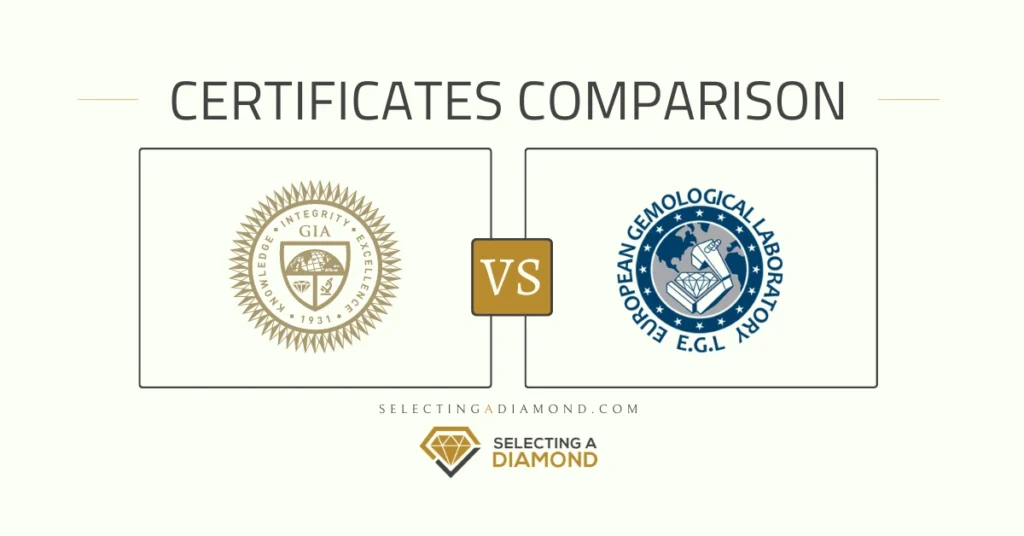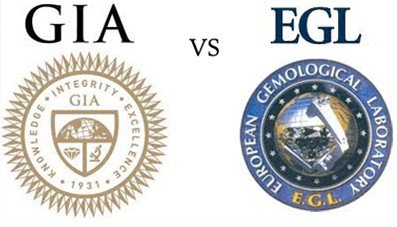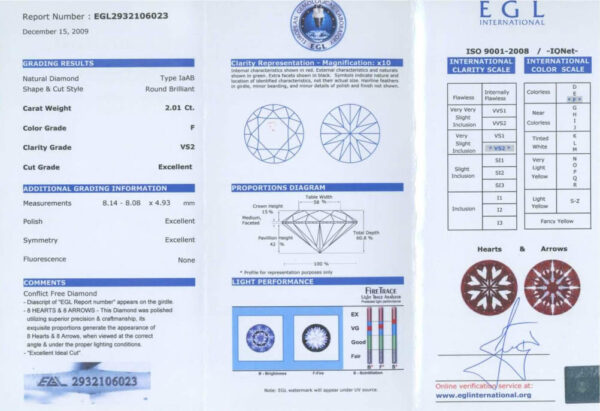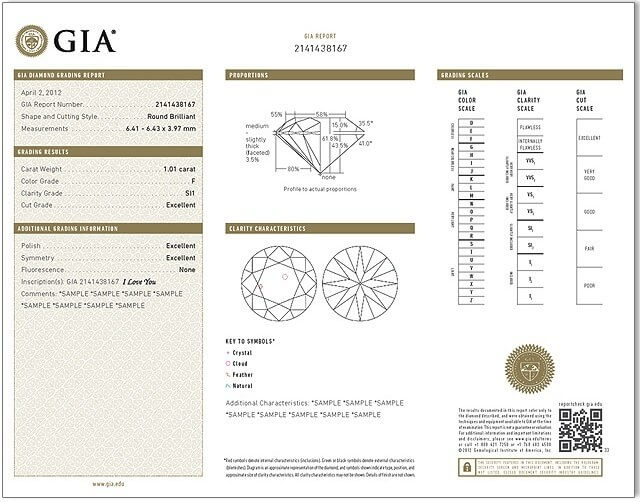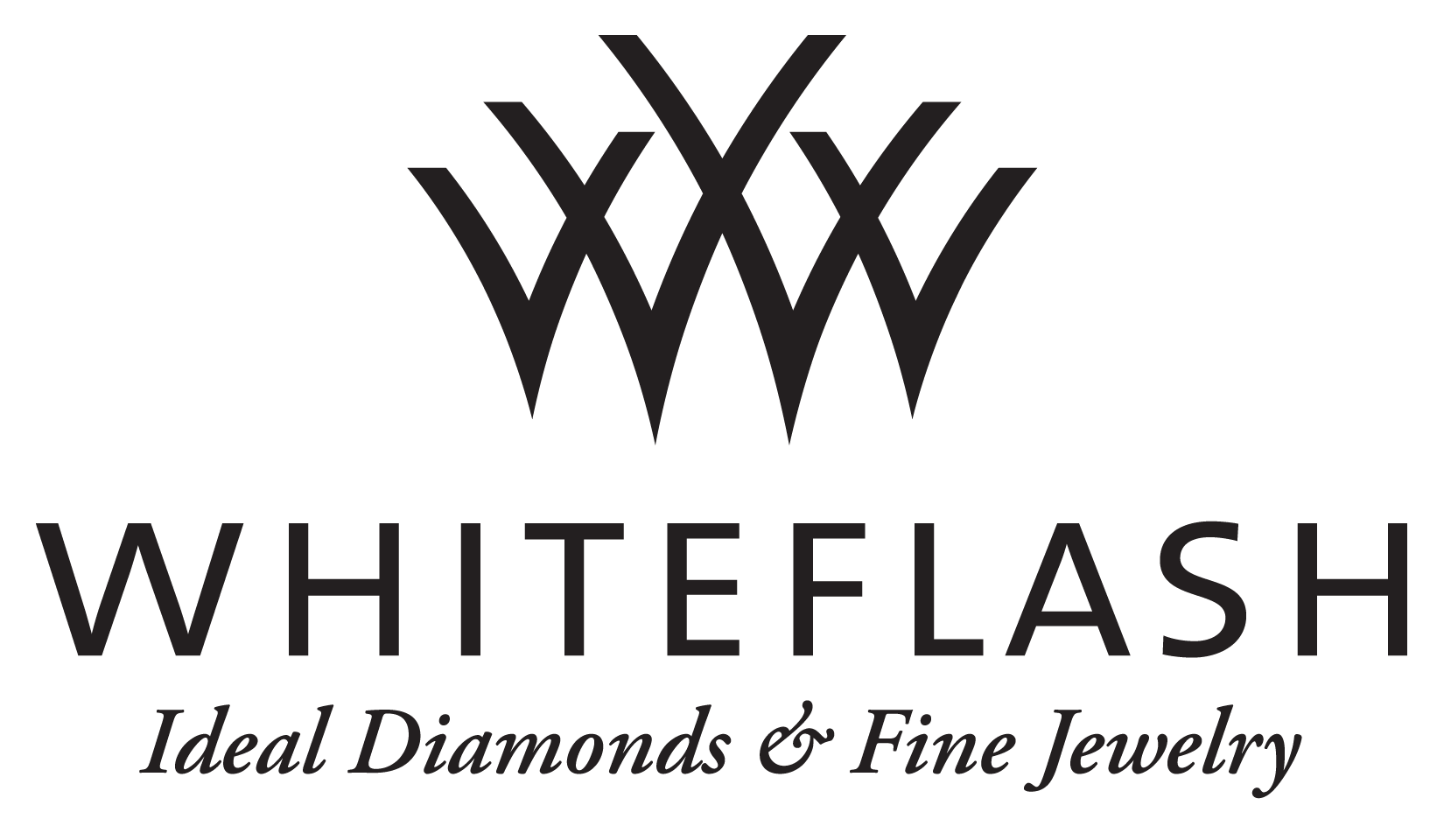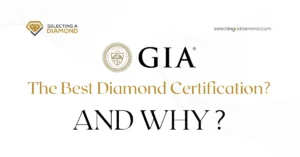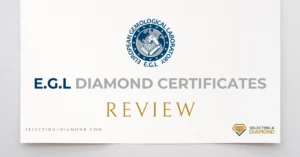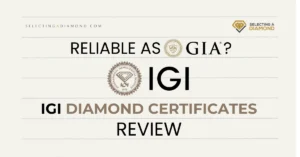When purchasing precious gemstones such as diamonds, certification plays a pivotal role.
Among the various entities that offer diamond grading, the Gemological Institute of America (GIA) and the European Gemological Laboratory (EGL) often rise to prominence.
However, despite their standing in the industry, there are notable differences between their grading standards and practices.
Look at this diamond on eBay (here is a saved image for the diamond in case got unlisted), the diamond has a D color on its EGL certificate, now let’s take a look at this D color diamond on Blue Nile that’s certified by GIA.
Would you ever believe both are the same color grade? Well, we wouldn’t!
In this article, our objective is to undertake a comprehensive comparison between EGL and GIA, investigating their methodologies, credibility, and the effects their respective grading can have on the overall value of a diamond.
The European Gemological Laboratory – EGL
When exploring the complex world of diamond certification, the name “European Gemological Laboratory,” or EGL, often emerges.
Since its establishment in the 1970s, EGL has burgeoned into a global network of gemological laboratories, with locations spanning London, Paris, Mumbai, Hong Kong, Tel Aviv, among others. Yet, the growth and structure of EGL have rendered it distinct from many of its industry counterparts.
EGL, unlike typical gemological laboratories, operates more akin to a franchise, with each location functioning under its own set of rules and standards. Rather than embodying a cohesive, centralized operation, the labs within the EGL network follow a decentralized model. Each of these laboratories, though bearing the EGL brand, uphold their own grading practices, resulting in varied levels of grading rigor and consistency across the network.
Despite the disparities in their operational standards, these individual laboratories are united under the EGL umbrella, contributing to the organization’s extensive team of over 1,100 scientists, researchers, and educators.
However, it’s worth noting that this diversity in grading standards across locations can affect the consistency and reliability of EGL certifications.
One of EGL’s unique contributions to the gemological world is the introduction of a clarity grade for diamonds weighing less than one carat: the SI3 grade. This grade straddles the boundary between slightly included (SI) and included (I) grades, catering specifically to the nuances of smaller diamonds.
Whether this development serves as an advantage or a stumbling block for EGL is a topic we’ll delve into in the following sections.
Before we further explore EGL’s contributions and shortcomings, let’s pause for a brief overview of the Gemological Institute of America (GIA), one of EGL’s prominent industry counterparts.
A comparison between these two entities will offer a broader perspective on EGL’s standing in the gemological landscape.
Gemological Institute of America – GIA
In stark contrast to EGL, the Gemological Institute of America (GIA) operates as an independent, non-profit organization. Founded in 1931, the GIA has sought to provide a guiding light in the form of standards, research, and education for not only purchasers and merchants but also the entire gemstone industry.
Fast forward to today, and the GIA employs over 3000 staff across their offices scattered across 13 countries. This extensive network includes their headquarters in California, 11 campuses, 9 laboratories, and 4 research centers worldwide, all dedicated to upholding GIA’s mission.
A GIA certification is a globally recognized standard in diamond grading, a testament to the organization’s exacting levels of inspection. GIA’s stringent guidelines ensure that any diamond bearing their certification has been meticulously tested and verified. The data provided in a GIA certificate is guaranteed to be reliable and precise.
The GIA’s influence extends beyond their rigorous certification process.
Did you know that the GIA is the pioneer of the globally accepted diamond grading standard, the 4Cs (Cut, Carat, Clarity, and Color)?
In the 1940s, GIA introduced the world to the 4Cs and the International Diamond Grading System™, which remain the universally accepted standards for evaluating diamond quality to this day.
Beyond grading and standardization, GIA has made significant strides in diamond education. Since their first online course in 2009, they have consistently provided a wealth of knowledge through various online courses and a plethora of informative articles.
As a result, anyone can join the GIA alumni and contribute to the expanding pool of gemological knowledge.
Now that we have shed light on the industry’s two main players, EGL and GIA, it’s time to delve deeper into their comparative advantages and shortcomings.
Although referring to EGL as a competitor to GIA might raise some eyebrows, it is interesting to examine the unique contributions each has made to the diamond industry.
Let’s probe further to discover whether these benefits are more skewed towards the merchant or the buyer.
EGL vs. GIA: Where EGL Succeeded?
As a profit-oriented entity, distinct from non-profit organizations like the GIA and AGS, EGL chose a path that uniquely catered to the needs of diamond merchants. The issues they sought to resolve were:
1. Speed
The certification processes of both AGS and GIA were considered slow, causing delays for merchants. Maintaining a robust inventory is essential for a diamond merchant, even more so before the advent of online stores like James Allen or Blue Nile. The delay in certification could cause significant disruptions to a merchant’s business.
In response, EGL prioritized expediting the process, allowing merchants to get their diamonds back quicker. By doing so, merchants didn’t have to keep their paid-for inventory out for months for certification by GIA or AGS. EGL’s swift certification became a valuable asset for these merchants.
2. Cost
The cost of certification by AGS and GIA typically exceeded that of EGL. Since EGL certified diamonds at a quicker pace, the process was shorter, more straightforward, and consequently, less costly. As EGL focused on volume, they were able to further decrease the prices. Thus, certification costs for diamond merchants were approximately 20% lower with EGL than with GIA.
3. Low Clarity Grades
Diamond clarity significantly influences buyers’ decisions. Merchants often struggle to sell diamonds that fall under the I diamond clarity grade (for example, I1 or I2). Note that this I does not pertain to the color grade I.
GIA and AGS grade a wide variety of diamonds that fall into the I clarity grade. To address this issue, EGL introduced an innovative grading technique, the SI3 grade. Rather than marking a diamond with an I1 grade, which is notoriously difficult to sell, EGL created SI3, ostensibly a higher level on the SI scale.
In essence, EGL founded the SI3 grade to help merchants avoid using the less desirable I family grade, where “I” denotes “Included”, indicating visible inclusions to the naked eye. Consequently, EGL replaced the I clarity level with the new SI3 grade. For instance, in a comparison of EGL vs. GIA regarding low clarity grades, a diamond that would receive an I2 or I1 grade from GIA might be classified as SI3 by EGL, offering a distinct advantage for merchants.
4. Grading Leniency
Among the various labs in the industry, only a few like GIA, AGS, and IGI are recognized for strict and consistent grading, with IGI now joining the ranks.
While the diamond grading system is generally accepted, it’s not obligatory, allowing each certifying company to utilize its own measurements. Noting that merchants could benefit from higher diamond clarity and color grades, EGL adopted a more lenient grading approach.
It’s common to find diamonds with EGL grades that are two levels higher than their GIA counterparts. For example, a diamond that GIA would grade as H or I color might receive an F grade from EGL.
EGL Vs. GIA: What it Means For You; The Consumer!
Until now, we’ve focused on the benefits that EGL brings to merchants, but what does this mean for you, the buyer?
In brief, we suggest exercising caution when considering EGL-certified diamonds! As you’ve seen, most of EGL’s offerings are tailored to favor the merchant.
EGL is known to grade diamonds with higher grades (both in color and clarity) than their actual grades, at more affordable prices. But why are these diamonds cheaper?
The answer lies in the industry’s perception of EGL’s quality, which is regarded as inferior to that of GIA. This perceived lower quality leads to discounted wholesale prices. These savings (or a portion of them) can then be passed on to the consumer.
We’ve encountered many instances where EGL diamonds, with similar grades to GIA or AGS stones, are priced just lower (e.g., a salesperson presents you with an EGL H-SI1 diamond and a GIA H-SI1 diamond).
In such cases, it’s reasonable to suspect that the merchant might be taking undue advantage. For instance, it’s plausible that the GIA would grade the same diamond as an I-I1.
If you feel our caution is excessive, consider this: neither Blue Nile nor James Allen, two of the leading online diamond retailers, list EGL-certified diamonds in their inventories, actually if you go over any reputable online diamond store, you won’t find any EGL-graded diamond!
The online diamond business is heavily dependent on certification standards, which is why they only deal with diamonds certified by the most reputable organizations.
One final point to note is that EGL operates many locations, each functioning as an independent business. Therefore, EGL Los Angeles is entirely distinct from EGL Israel.
While we generally advise caution with both, it’s worth noting that EGL LA does hold a somewhat better reputation.
Analyzing GIA and EGL USA: Differences in Grading
Let’s delve into the distinctive grading standards of the Gemological Institute of America (GIA) and the EGL USA.
As previously mentioned, GIA’s grading methods are stringent and uniform across their labs, yielding highly dependable reports.
Conversely, EGL USA is known to grade somewhat generously, often assigning one to two grades higher than the actual value, even though EGL USA is reputed to have tighter standards than the broader EGL network.
Understanding what these disparities imply for you as a customer when weighing EGL USA against GIA grades is crucial.
Variation in Color Grading
A diamond’s color grade refers to its level of whiteness, with D being the highest grade and Z the lowest. For instance, if a diamond earns a G color grade from GIA, EGL USA might grade it differently. Known for its propensity to grade up to two color grades higher, the EGL USA could rate the same diamond as E, while GIA might assign it a G.
Differences in Clarity and Cut Grading
EGL USA is renowned for grading up to a full grade higher on both clarity and cut. For example, GIA might grade a diamond as VS1 for clarity and Very Good for cut. However, when evaluated by EGL USA, the same diamond might receive a VVS2 for clarity and an Excellent for cut, one grade higher in both categories.
Consistency in Carat Measurement
Carat refers to the weight of the diamond and is the one aspect of the “4Cs” that remains consistent between EGL USA and GIA evaluations.
EGL vs. GIA: The Summary
- EGL operates on a decentralized model, leading to diverse grading standards.
- GIA is recognized for its rigorous, globally accepted certification process.
- EGL’s certification is quicker, more affordable, and leans towards lenient grading, benefiting diamond merchants, yet potentially deceiving consumers.
- The diamond industry tends to view EGL’s certification as of lower quality. This viewpoint is supported by top online diamond retailers who do not offer EGL-certified diamonds.
- EGL’s independent operation of different labs may influence grading consistency.
- Buyers should exercise caution when considering diamonds graded by EGL
Still not sure where to buy your diamond?
We always recommend shopping diamonds online and created a Full guide to shop diamonds like a Pro.
Among online retailers, here are our favorite stores click their logo to visit store
-
James Allen:
Our favorite online store, best diamond imaging technology available today, comes with the largest collection with more than half a million loose diamonds.
-
Blue Nile:
Widest collection of loose diamonds of all sizes, great imaging technology for most of their inventory (hundreds of thousands of diamonds), great customer support.
-
Whiteflash:
Home Of A CUT ABOVE® Super Ideal Diamonds, they stand out from the crowd by offering premium diamonds cuts, tailored to those who love the details, at great prices too.

